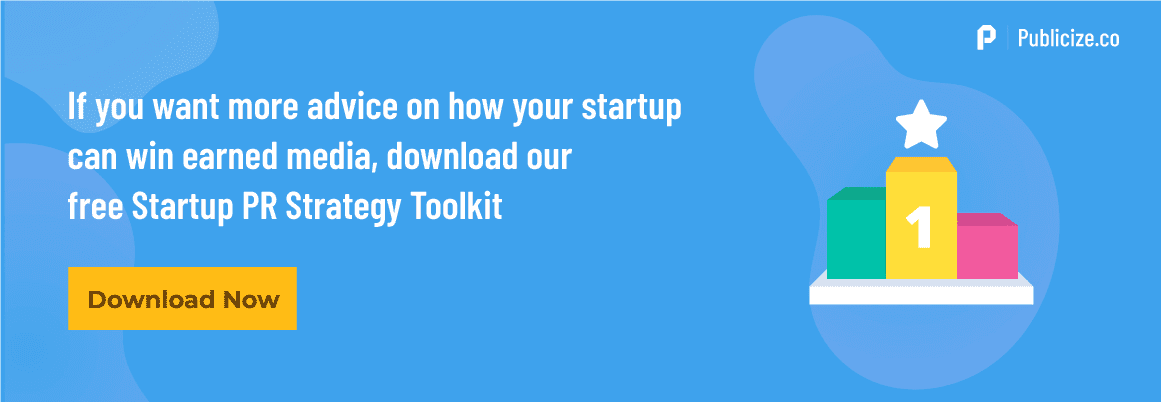“Advertising is what you pay for, publicity is what you pray for,” or so says the popular business proverb. This, in a nutshell, summarizes the difference between advertising and public relations.
Somewhat surprisingly, considering the importance of both strategies, 59 % of executives in a New Jersey study said that they “do not fully understand the role and capabilities of PR.”
So, what is PR then?
Put simply, public relations is a way for businesses to communicate with the public and the media in order to craft a positive image. This could be through contacting journalists and editors with launch announcements, crafting thought leadership articles for top-tier publications, featuring on a radio or TV interview, podcast, or product review. This content isn’t paid by companies, but featured by publications in order to provide value to their audiences.
On the other side of the coin, we have advertising and paid media – a way of directly encouraging the public to buy your products through paid ads. The industry has advanced a lot since the bygone ‘Mad Men’ era of the sixties, and no longer only means billboard ads, with corny lines and come hither pin-ups.
New forms of digital advertising such as paid native ads (also known as sponsored content) aim to promote a product or brand through an article, using the same editorial style as regular guest contributions. This sometimes makes it difficult to differentiate from PR.
Nevertheless, as a business leader you need to know the ins and outs of PR vs advertising strategy in order to leverage both. With this in mind, I’ve listed the most significant differences between PR and advertising that you should know about.
1. Earned media has higher consumer trust than paid media
When it comes to promoting your product or announcement, advertising lets you tell people what you are doing and PR means someone else is doing it for you.
They’re not doing this because you paid them, but because they’ve recognized something newsworthy in your product or announcement; perhaps it ties into an emerging trend, or you already have recognized experiences or a strong online presence and a powerful mission.
This is the difference between paid and earned media.
A nod from the media – a social influencer, product review site or industry expert – can carry great weight when building trust with your customers.
Nielsen study revealed that when it comes to making purchase decisions, “articles from credible journalists” evoke greater consumer trust than branded content. In other words, you’re far more likely to follow the advice of an independent voice than a pushy salesman with a vested interest.
If you want to get your business announcement covered by the media, you’ll need to create a press release and pitch. Your press release should be no longer than 500 words, and must clearly explain your product or service, how it works, and why it’s important, with accompanying quotes that explain your vision.
Give context and facts, not opinion, and avoid any ambiguity or superlatives, it’s the journalist’s job to create the narrative. You sell your story on the strength of your product and announcement, not by telling people how great you think it is.
2. PR means meaningful guest posts instead of promotional sponsored content
We’ve seen the recent and rapid growth of a $30 billion a year sponsored content market.
These articles are different from a normal editorial contribution and, though they’re often informative and entertaining, they always lead the reader to the same conclusion; your product breaks the mold, solves the problem, and should be purchased right away.
This can be an effective way to get visibility, but can also cost a lot of money. Three months on Forbes’ Brand Voice platform, for example, can cost between $50,000 – $75,000.
When you consider that just 24% of readers consume native ad or sponsored content compared to “normal” editorial which is read by 71% of the audience , you can understand why this isn’t always so desirable to advertisers.
Thought leadership articles, on the other hand, won’t cost you a cent, and won’t have any off-putting disclaimers. However, they have an entirely different purpose.
Contributed guest blogs need to be non-promotional: unlike sponsored content, they don’t provide an opportunity for you to advertise your product. Instead, thought leadership articles provide a chance for business leaders to talk on an industry topic and offer insight and expertise.
In order to take advantage of this economical source of PR, your article must be of true value to the readerships, or commissioning editors will roundly reject your submission.
Guest blogging contributions often take the form of useful How to articles, tips and tricks, industry insight pieces that add to debates, or articles that identify or solve common business problems. Remember, the media owes you nothing and isn’t there to help you peddle your business; rather it must offer interesting content that excites its readership.
However, there’s no need for choosing either or. By aligning your digital advertising and PR efforts, you can leverage both guest blogging and sponsored content.
3. Effective PR builds credible and lasting social proof instead of a short-lived existence in the spotlight
So, we’ve identified that PR creates trust and engages audiences, but if you aren’t getting typical ad direct response metrics, what’s the point?
Of course, there are the views, clicks, landing page hits and even sales that demonstrate direct ROI from PR. Furthermore, a powerful backlink from a top-tier site does wonders for your SEO ranking. But much more than this, effective PR carries great weight on a qualitative level.
One of the greatest benefits of successful PR is the power of brand association. You got your name on a top-tier publication and, without that ‘Sponsored’ label, you are starting to build real, credible social proof for yourself as a professional and the company you represent.
Googling your company or business will now no longer pull up your website, social media accounts, or your content marketing or native ad spots.
Instead you have an independent review from the NYT, a local TV interview, or your recent insights on the state of the startup world on Techcrunch that’ll stay in the search results without you having to pay for it.
Although, it has to be admitted that accomplishing the above is much harder than getting visibility through advertising. However, once your advertising budget runs out, your short moment of fame is over and there will be no credible social proof to show for it.
4. Advertising has better control over it’s message than PR
If you need visibility fast, know exactly what message you want to convey, and have the budget for it, advertising is your best ally.
PR wins take longer to achieve and hours of hard work go to every piece of successful earned media. Additionally, every time a journalist accepts your pitch to write a piece about your company, there’s a risk that the message isn’t exactly what you wanted it to be as the journalist has all the editorial control.
Even if paid media has lower consumer trust than earned media, it still can bring exceptional results if your digital advertising campaigns are managed effectively and aligned with your PR strategy.
Final thoughts
As Richard Branson–PR pro, stuntman and CEO of Virgin Group–famously said, “A good PR story is infinitely more effective than a front page ad.”
While you might not be planning to fling yourself off a 407-foot casino any time soon, those that can figure out PR, can reap the rewards by building lasting relationships with the media and by creating strong social proof.
However, the key in understanding the differences between PR vs advertising is to understand their strengths and weaknesses. Don’t look at them as opponents, but combine them to create a bulletproof communications strategy.







